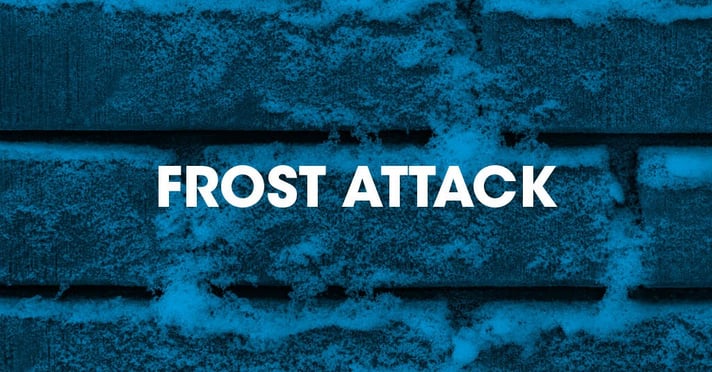Why do we require freeze/thaw resistant brickwork?
Frost attack can occur through the repeated action of rain water freezing and thawing. When water turns into ice, there is increase in volume which can eventually cause stresses to masonry units and lead to spalling. This can be avoided by specifying freeze/thaw resistant bricks in areas that are prone to prolonged periods of saturation.
Common influences of frost attack
A number of factors can influence frost attack, these include (but are not limited to):
- Freeze/thaw resistance of the masonry units.
- Saturation of the masonry.
- Degree of exposure to wind driven rain.
- Localised protection from other buildings, topography, roof overhangs, copings or capping.
How to lessen the risk of frost attack
- Masonry and mortar specification should be in accordance with PD 6697.
- As a quick guide, Freeze/thaw resistant masonry units should be selected using the recommendations in the following table. For further detailed guidance please refer to PD 6697.
- Parapet walls should have a coping or capping (for further guidance on parapet walls, see section 6.6 of our Technical Manual).
- Sills and coping should have a weathered upper surface.
- Paths around the building should drain away from walls to avoid saturating brickwork.
- External painted finishes on brickwork has the potential to trap moisture and as such the manufacturer should be consulted to ensure the decorative finish will not have a detrimental impact on brickwork durability.
- Masonry units with low soluble salts should be specified where there is a risk of brickwork being persistently wet.
- Most concrete bricks have a strength of 22N/mm2 and are durable in most situations and are equivalent to frost resistance class F2 for clay bricks. For copings and sills, bricks with a compressive strength of 36N/mm2 should be used.
- Concrete blocks used in the outer leaf without protective cladding or render must have a compressive strength >7.3N/mm2 or have a density of at least 1,500kg/m3
- In Scotland, all clay bricks used externally should be frost-resistant, F2, S2 or F2, S1 to BS EN 771-1 and all concrete bricks used as facings should be 22 N/mm2 to BS EN 771-3.
- In areas of severe and very severe exposure to wind driven rain, the following should be specified:
- Clay facing bricks which are frost-resistant F2, S2 or F2,S1 to BS EN 771-1.
- Concrete bricks with a minimum strength of 22N/mm2 to BS EN 771-3.
- Concrete blocks with a minimum density of 1,500kg/m3 or compressive strength greater than 7.3N/mm2.
- Calcium silicate masonry units must be confirmed to be F2 rated to BS EN 771-2 by the manufacturer.
- Most types of aircrete blocks with render.
If there are any doubts about the suitability of facing bricks in areas of severe frost exposure, written clarification by the brick manufacturer confirming the suitability of the brick should be provided.
|
Freeze/thaw resistance category |
Possible use case |
|
F2 – Severe exposure to freeze/thaw |
Can be used in normal building situations and all exposures to wind driven rain. F2 rated masonry units should be used:
|
|
F1- Moderate exposure to freeze/thaw |
Provides a moderate freeze/thaw resistance and in general F1 rated masonry units can be used between DPC and eaves. However they should not be used in areas of severe or very severe exposure to wind driven rain or elevated sites. |
| F0 – Passive exposure to freeze/thaw | Not freeze/thaw resistant – should not be used externally unless completely protected by impermeable cladding |
* Please note, possible use cases are not an exhaustive list. In all situations, confirmation of suitability of the masonry unit for the intended use must be confirmed by the manufacturer of the masonry units and reference to PD 6697
Warranty stance
Although frost attack can cause significant stresses in the masonry units, the specifier can mitigate this risk by ensuring the units have an appropriate durability. In addition, various design elements can also help lessen the risk of frost attack as highlighted in this article.

